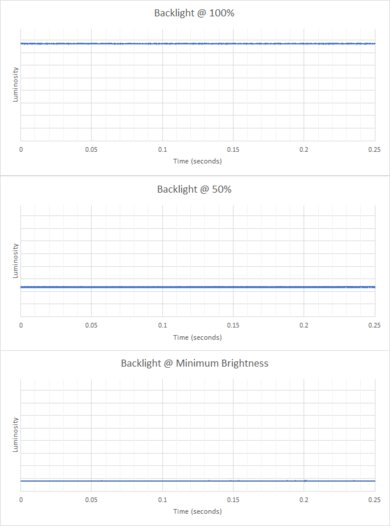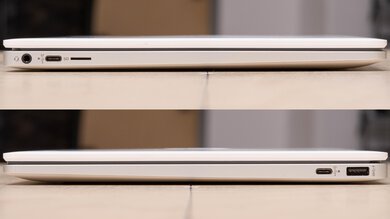The HP Chromebook 14 (2021) is a budget Chrome OS laptop. It's part of the HP 14a-na0000 series of Chromebooks. It's available with Intel Celeron or Pentium Silver CPUs, integrated graphics, 4GB or 8GB of memory, and up to 128GB of eMMC storage. There are also multiple display options; you can choose between a TN 720p panel (with or without support for touch input) and a 1080p IPS panel. It has a 720p webcam, Wi-Fi 5 wireless connectivity, and a 47Wh battery. Ports include one USB-A, two USB-Cs, a MicroSD card reader, and a 3.5 mm headphone jack.
See our unit's specifications and the available configuration options in the Differences Between Variants section.
Our Verdict
The HP Chromebook 14 is decent for school use. It's a compact laptop that's easy to carry around and has exceptional battery life. You have to be careful with it, though, because it doesn't feel particularly well-built. The keyboard feels good to type on, and the touchpad is decent. Its TN panel doesn't look particularly sharp, but you can get a model with a higher resolution 1080p IPS display. Unfortunately, glare is a problem in well-lit environments because the screen doesn't get very bright. The CPU and integrated graphics can handle light workloads like web browsing and video playback, but they aren't powerful enough for demanding tasks like 3D design.
- Compact size.
- Long battery life.
- Decent touchpad.
- Keyboard feels good to type on.
- CPU and GPU not powerful enough for heavy workloads.
- Poor webcam video quality.
- Limited port selection.
- Dim display.
The HP 14 Chromebook is bad for gaming. You can't install any DirectX games on Chrome OS, so you're limited to games from the Google Play Store. Even then, this laptop's low-power CPU and integrated graphics will likely struggle in highly demanding titles. Also, some games might not run properly since they're designed for Android smartphones and tablets, and the screen is limited to a 60Hz refresh rate with no VRR support. On the bright side, it doesn't get overly hot under load, and it's silent due to its fanless design.
- Silent under load due to fanless design.
- CPU and GPU not powerful enough for heavy workloads.
- Limited port selection.
- No user-upgradeable parts.
- 60Hz display and no VRR.
- Can't install x86 applications.
The HP 14 Chromebook is sub-par for media consumption. Its low-resolution TN panel looks washed out due to its narrow color gamut. You can get a model with a sharper 1080p IPS display, but it'll perform similarly. Also, it isn't ideal for dark room viewing due to its low contrast ratio, and it doesn't get bright enough to overcome glare in well-lit settings. The speakers sound relatively balanced despite the lack of bass, but they don't get very loud. It's very portable, though, and the battery lasts long enough to get you through a couple of movies and TV shows.
- Compact size.
- Long battery life.
- Speakers good for spoken content.
- Low-resolution display looks washed out and inaccurate.
- Dim display.
- Blacks look gray in dim environments.
- Poor viewing angles.
The HP 14 Chromebook is bad for use as a workstation. It's only available with low-power CPUs, integrated graphics, and up to 8GB of RAM, so it isn't powerful enough to handle demanding workloads like video editing or 3D design. Also, most professional programs don't run on Chrome OS.
- Silent under load due to fanless design.
- CPU and GPU not powerful enough for heavy workloads.
- Limited port selection.
- No user-upgradeable parts.
- Slow storage drive.
- Can't install x86 applications.
The HP Chromebook 14 is inadequate for business and light productivity. It doesn't feel particularly well-built, but it's very portable, and its battery lasts easily through a typical workday. The keyboard feels good to type on, and the touchpad is decent; however, it has a mediocre port selection and a poor-quality webcam. Unfortunately, the CPU doesn't have enough processing power to handle demanding tasks or heavy multitasking. Also, you can't install any x86 applications on Chrome OS.
- Compact size.
- Long battery life.
- Decent touchpad.
- Keyboard feels good to type on.
- CPU and GPU not powerful enough for heavy workloads.
- Poor webcam video quality.
- Limited port selection.
- Dim display.
- Can't install x86 applications.
Changelog
- Updated Feb 22, 2024: We've updated the review for clarity and readability.
- Updated Jan 23, 2024: Added mention of the Acer Chromebook Plus 515 (2023) as an alternative with faster CPUs in the CPU section.
- Updated Dec 07, 2023: Converted to Test Bench 0.8.2.
- Updated Nov 03, 2023: Converted to Test Bench 0.8.1.
Differences Between Sizes And Variants
We tested the HP Chromebook 14 (model 14a-na0021nr) with an Intel Celeron N4000 CPU, Intel UHD Graphics 600, 4GB of RAM, and 32GB of storage. The display, CPU, memory, and storage are configurable; you can see the various configurations in the table below. This review applies to all variants in the HP 14a-na0000 series of Chromebooks.
|
Screen |
|
|---|---|
| CPU |
|
| GPU |
|
| Memory |
|
| Storage |
|
| Color |
|
See our unit's label here.
Popular Laptop Comparisons
The HP Chromebook 14 is a decent Chrome OS laptop with a comfortable keyboard and long battery life. However, there are better options in its price range, especially when it comes to build quality.
For more options, check out our recommendations for the best Chromebooks, the best laptops for college, and the best budget laptops.
The Acer Chromebook 315 (2020) and the HP Chromebook 14 (2021) are both Chromebooks with power-efficient Intel Celeron CPUs. However, the Acer is better for productivity tasks and multimedia viewing because it has a larger, much more color-accurate 15-inch display that gives more room to multitask. It also has a better selection of ports and a far better webcam and microphone. On the other hand, the HP is a much more portable device, with a longer-lasting battery for web browsing and much better-sounding speakers.
The Lenovo IdeaPad Slim 3i Chromebook 14 (2023) is better than the HP Chromebook 14 (2021) for most uses. The Lenovo has a sturdier build, a brighter display, and a better 1080p webcam. It also has a wider port selection, a faster Wi-Fi 6E wireless adapter, and better CPU performance. However, the HP has a slightly better keyboard and touchpad, and its battery lasts almost three hours longer.
The Acer Chromebook Plus 515 (2023) is better than the HP Chromebook 14 (2021) for most uses. The Acer has a sturdier build and a much better webcam, and it's available with significantly faster Intel Core CPUs to provide a smoother and snappier desktop experience. On the other hand, the HP is more portable since it's a smaller 14-inch device, and its battery lasts over 16 hours of light use, which is almost twice as long as the Acer's.
The Acer Chromebook Spin 713 (2020) and the HP Chromebook 14 (2021) are both Chrome OS devices, but the Acer is a convertible 2-in-1 you can use in tablet mode, whereas the HP is a traditional laptop without a touchscreen. The Acer is better for productivity and multimedia viewing, with a much better webcam and microphone, a more flexible port selection, and a much brighter and more colorful display with a higher resolution. Also, it can be equipped with a much better CPU, more RAM, and faster storage, which will make it extremely fast and powerful. On the other hand, the HP's battery lasts longer, and since its speakers get louder, you can hear audio better in loud environments.
Test Results

The HP Chromebook 14a has an unremarkable design that looks a little cheap. It has a silver-color plastic chassis, white keys, and fairly thin bezels with a thicker bottom chin. It's a fanless device and doesn't have any air vents. It's available in three color schemes: Mineral Silver, Ceramic White, and Forest Teal. If you prefer a 2-in-1 convertible laptop that you can use as a tablet, check out the Acer Chromebook Spin 311 (2021).
The build quality is mediocre. It's entirely plastic, with a lot of flex in the display and keyboard deck. The flex isn't awful but still noticeable. We chipped the edge while accessing the internals, which doesn't speak well for the overall build quality. If you're looking for a similarly priced Chromebook but want something that feels much better built, check out the Lenovo Chromebook Flex 5 (2020).
The HP 14 Chromebook's serviceability is bad. It's hard to access the internals as you need to remove eight screws, six of which are beneath the feet. The feet themselves felt brittle and broke when we removed them, and a few plastic pieces also came off when we removed the panel. The memory and storage are soldered on, so there's no way to upgrade them.
See the maintenance and service guide here.
The HP Chromebook 14 is available with the following displays:
- 14" TN 1366 x 768 60Hz 220 cd/m²
- 14" TN 1366 x 768 60Hz 220 cd/m² touchscreen
- 14" IPS 1920 x 1080 60Hz 250 cd/m²
The TN panels have a low resolution, so they don't look particularly sharp. The 1080p IPS display looks much sharper, with a pixel density of 157 PPI. Its 16:9 aspect ratio is great for media consumption; however, a 16:10 or 3:2 aspect ratio would have been preferable for productivity, as the additional vertical space will allow you to see more information, so you won't have to scroll as much. If you're looking for a portable Chromebook but want a taller 3:2 display for more vertical space, check out the HP Chromebook x360 12 (2021).
All the display options are limited to a 60Hz refresh rate with no VRR support. The TN panel has a very slow response time, causing noticeable ghosting, so it's not the best for viewing fast-moving content or gaming. The other panels perform similarly. If you want a Chromebook with a higher refresh rate and faster response time, check out the Acer Chromebook 516 GE (2022).
The screen brightness is mediocre. It's a little better than the advertised 220 cd/m², but still not enough to overcome glare in well-lit or sunny environments. The 1080p screen is advertised to have 250 cd/m² brightness, which is a small difference that's barely noticeable. It gets very dim at the lowest brightness setting, making it ideal for dark room viewing as it causes less eye strain.
The reflection handling is good. The matte coating works well against direct reflections, but it's likely that you'll still have trouble with glare due to the screen's low brightness, especially in sunny environments.
The TN panel's horizontal viewing angle is bad. The gamma shifts almost as soon as you move off-center. If you want better viewing angles, it's best to go with the 1080p IPS display instead of the TN panels.
The display's vertical viewing angle is bad, mainly due to the TN panel's chroma inversion. The image looks very inaccurate if you're viewing it even slightly from above or below, which limits the angle at which you can tilt the screen. If you want better vertical viewing angles, it's best to get a model with a 1080p IPS panel.
The display's out-of-the-box color accuracy is awful. Most colors and the white balance are inaccurate. This is mainly due to the TN panel's narrow color gamut, as well as an overly cool color temperature making everything look blue. The gamma isn't bad, though some scenes are a little too dark, and very bright scenes are over-brightened.
The TN panel has a poor color gamut. It doesn't even have full sRGB coverage, the color space used in most web content. It also has bad coverage of the wider Adobe RGB, DCI P3, and Rec. 2020 color spaces, so it isn't ideal for color-critical work. All three display options are advertised to have 45% NTSC coverage.
The HP Chromebook 14a has an okay keyboard. It feels good to type on as the keys are stable and comfortably spaced out, but they have a lot of travel for a laptop keyboard, which some people might not like. Unfortunately, there's no backlighting, so it isn't the best option for use in dark environments.
The touchpad is of a decent size and responsive. It tracks well, and gestures work as intended. You can click anywhere on the touchpad, even near the top edge, but you have to press hard to make it work. Clicking and dragging works for the most part, although your finger might hit the edge of the touchpad before getting from one corner of the screen to another.
The speakers are good. They sound fairly neutral despite having almost no bass, but they don't get very loud.
The webcam's video quality is bad, as the image lacks fine details and looks overexposed and unnatural. The microphone sounds quiet, with a noticeable amount of static in the background.
The port selection is passable. Both USB-C inputs support charging and USB 3.2 Gen 1 data transfer speed (up to 5Gbps), but only the port on the right side supports video output to an external display (DisplayPort 1.2 standard). The USB-A port is also USB 3.2 Gen 1 (up to 5Gbps). If you're looking for a Chromebook and want a better port selection, check out the Acer Chromebook 315 (2020).
The HP 14 Chromebook's wireless adapter is a Realtek RTL8822CE.
The HP Chromebook 14 is available with the following CPUs:
- Intel Celeron N4000 (2 cores/2 threads, up to 2.6GHz)
- Intel Celeron N4020 (2 cores/2 threads, up to 2.8GHz)
- Intel Pentium Silver N5000 (4 cores/4 threads, up to 2.7GHz)
- Intel Pentium Silver N5030 (4 cores/4 threads, up to 3.1GHz)
All of the available CPUs are low-power processors designed for light tasks like text processing, web browsing, and video playback. If you only use a few applications at once and don't stress the system much, you can likely get by with the dual-core N4000 or N4020; however, if you're a heavy multitasker or just want some processing headroom, then go with one of the quad-core Pentium Silver CPUs. Faster clock speeds usually result in only a small performance boost, so don't worry too much about choosing between the N4000 and N4020 or the N5000 and the N5030. If you want a Chromebook with faster CPU options, check out the Acer Chromebook Plus 515 (2023).
The HP 14 Chromebook is only available with integrated graphics. The Celeron processors have Intel UHD Graphics 600, while the Pentium Silver processors have Intel UHD Graphics 605. Both are integrated GPUs designed for light tasks, like web browsing and video playback. They can handle most games from the Google Play Store except for the most graphically demanding ones. The UHD Graphics 605 is faster than the UHD Graphics 600, but the difference is minimal.
You can configure this laptop with 4GB or 8GB of memory. However, 8GB is only available on the Pentium Silver models. 4GB is enough to run Chrome OS smoothly, but you'll experience slowdowns quickly if you have multiple applications or Chrome tabs open simultaneously, so it's only suitable if you have an extremely light workload. If you're a heavy multitasker, it's best to get 8GB.
You can configure the laptop with 32GB, 64GB, or 128GB of storage.
The HP Chromebook 14's Intel Celeron N4000 CPU has a terrible score in the Geekbench 5 benchmarks, performing badly in the single- and multi-threaded tests. This means it can handle light workloads like web browsing and video playback but struggles in demanding tasks like photo and video editing. Although we can't run the GPU compute test on our version of Geekbench 5, the Intel UHD Graphics 600 will likely perform just as poorly.
Cinebench R23 doesn't work on Chrome OS.
The eMMC drive has very slow read and write speeds. However, the laptop still feels reasonably fast and responsive because Chrome OS is a light operating system, and most tasks are web-based. The slow drive speeds mainly affect processes like launching or installing a large application and file transfers. The 64GB and 128GB storage options are also eMMC drives and will perform similarly.
Models with an FHD display will likely have a shorter battery life.
Borderlands 3 doesn't run on Chrome OS.
Civilization VI doesn't run on Chrome OS.
CS:GO doesn't run on Chrome OS.
Shadow of the Tomb Raider doesn't run on Chrome OS.
The thermal and noise performance is excellent. It gets a little toasty under load, with the hottest spot being around the number 4 on the keyboard, but it isn't uncomfortable. There's no fan, so the laptop is always silent.
We can't test the performance over time because UNIGINE Heaven and Cinebench R23 aren't compatible with Chrome OS. There's likely some performance loss, as it's typical for a fanless device.
The HP 14 Chromebook runs on Chrome OS, a lightweight operating system designed to run web apps, Android apps from the Google Store, and Linux apps. You can't install any x86 applications like the full version of Adobe Premiere or DaVinci Resolve. There aren't any additional software applications other than those that typically come with Chrome OS. If you need a laptop that can run full x86 applications, check out the ASUS VivoBook Flip 14 (2020).
Every Chromebook has an 'expiration date' at which it stops receiving software updates, and according to Google's official document, the HP Chromebook 14's end of life is June 2026. Google may extend this date as they have in the past for other Chromebooks; it's best to check their official document for any changes.
































